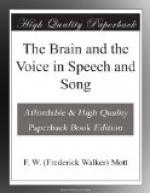Next I think it probable that the advance of receptual
intelligence which would have been occasioned by this
advance in sign-making would in turn have led to a
development of the latter—the two thus acting
and reacting on each other until the language of tone
and gesture became gradually raised to the level of
imperfect pantomime, as in children before they begin
to use words. At this stage, however, or even
before it, I think very probably vowel sounds must
have been employed in tone language, if not also a
few consonants. Eventually the action and reaction
of receptual intelligence and conventional sign-making
must have ended in so far developing the former as
to have admitted of the breaking up (or articulation)
of vocal sounds, as the only direction in which any
improvement in vocal sign-making was possible.”
Romanes continues his sketch by referring to the probability
that this important stage in the development of speech
was greatly assisted by the already existing habit
of articulating musical notes, supposing our progenitors
to have resembled the gibbons or the chimpanzees in
this respect. Darwin in his great work on the
“Expression of the Emotions” points to
the fact that the gibbon, the most erect and active
of the anthropoid apes, is able to sing an octave in
half-tones, and it is interesting to note that Dubois
considers his Pithecanthropus Erectus is on the same
stem as the gibbon. But it has lately been shown
that some animals much lower in the scale than monkeys,
namely, rodents, are able to produce correct musical
tones. Therefore the argument loses force that
the progenitors of man probably uttered musical sounds
before they had acquired the power of articulate speech,
and that consequently, when the voice is used under
any strong emotion, it tends to assume through the
principle of association a musical character.
The work of anthropologists and linguists, especially
the former, supports the progressive-evolution theory,
which, briefly stated, is—that articulate
language is the result of an elaboration in the long
procession of ages in which there occurred three stages—the
cry, vocalisation, and articulation. The cry
is the primordial, pure animal language; it is a simple
vocal aspiration without articulation; it is either
a reflex expressing needs and emotions, or at a higher
stage intentional (to call, warn, menace, etc.).
Vocalisation (emission of vowels) is a natural production
of the vocal instrument, and does not in itself contain
the essential elements of speech. Many animals
are capable of vocalisation, and in the child the
utterance of vowel sounds is the next stage after the
cry.




